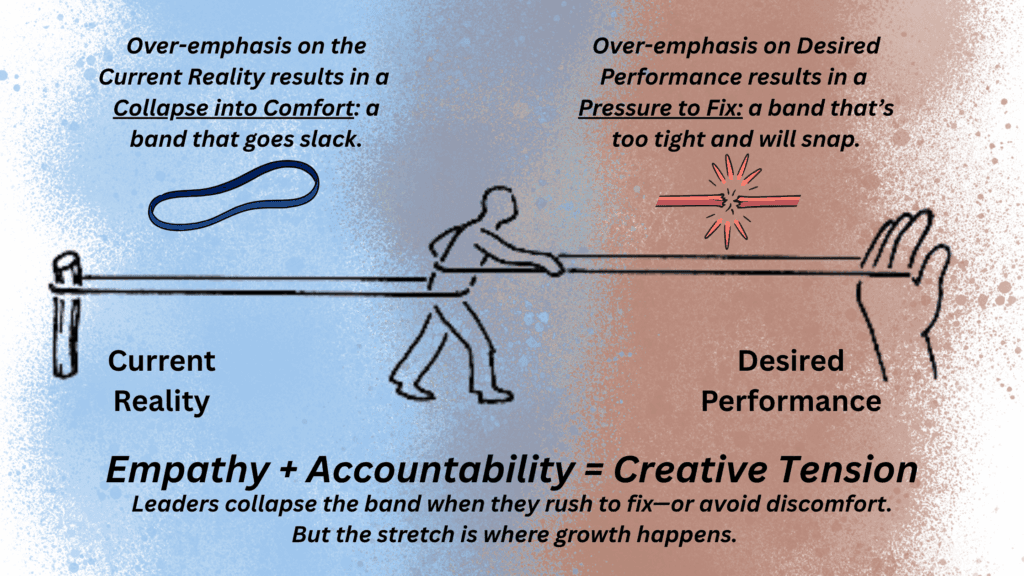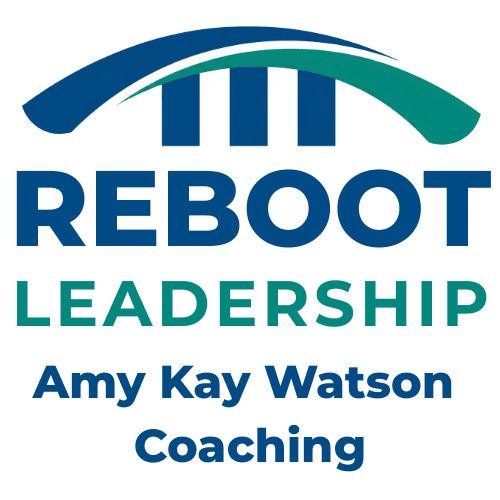Summary: Empathy isn’t about rescuing—it’s about staying present with the discomfort of growth. This post explores how leaders like Michele Lewis Reeves hold the tension between current reality and future potential, guiding performance improvement without collapsing into quick fixes. Through real stories and the lens of creative tension, it offers a model for lasting change.
When we think about improving performance, the first instinct is often to fix what’s broken.
But what if the real work isn’t fixing at all?
What if it’s holding—holding the tension between who someone is and who they could become?
Can I be empathetic without excusing underperformance?
That’s what Michele Lewis Reeves did.
She inherited an employee—let’s call him Ron—who was beloved by his peers but consistently underperformed. His performance reviews were quietly negative year after year, but no one had helped him grow. His generosity was real. So was his struggle.
Michele didn’t rush to solve him. She didn’t ignore the gap, either. She named it. Held it. And helped him move toward it.
Through creative experiments—whiteboarding, time-blocking, journaling—they clarified his goals and what was in the way. She didn’t collapse the tension. She used it.
By the next performance cycle, Ron’s progress was undeniable. Michele advocated for his raise—and he got it.
But not every story resolves so cleanly.
Michele also faced a direct report whose ambition turned adversarial. Despite empathy and open dialogue, trust never formed. Eventually, Michele made the call: this was a misalignment, not a project. Even that decision—rooted in clarity and care—was shaped by empathy.
What is Creative Tension, and how do leaders use it?
In The Path of Least Resistance, Robert Fritz writes that real change comes not from fixing problems, but from holding the creative tension between current reality and a compelling vision.
If you lose sight of the vision? You collapse into problem-solving. If you deny reality? You drift into fantasy.
Leaders who improve performance hold both:
- Here’s where we are.
- Here’s where we could be.
And then they stay with the tension long enough for change to emerge.
That’s what empathy makes possible. Not rescuing. Not over-accommodating. Presence. Patience. Persistence.

Holding tension is uncomfortable. How do I keep this up?
- Whether you’re facing a chronic underperformer or a rising star who’s lost their way—can you stay with the tension?
- Can you see them without excusing the gap?
- Can you name the vision without demanding instant change?
Empathy helps you hold the space.
Structure helps you shape it.
And together, they help people grow into it.
Let’s Reflect What helps you hold that creative tension when the easy thing would be to give up—or give in?
Frequently Asked Questions
Q1: How does empathy improve employee performance?
Empathy helps leaders understand root causes of underperformance, create psychological safety, and co-create realistic improvement plans—leading to sustained growth and engagementEmpathetic Leaders Driv….
Q2: What is creative tension in leadership?
Creative tension is the productive discomfort between where someone is now and where they want to be. Rather than rushing to resolve this gap, empathetic leaders stay with it—allowing growth to emerge organicallyThe Importance of Empat….
Q3: Can empathy coexist with accountability in performance management?
Absolutely. Empathy allows leaders to communicate expectations clearly while also offering support. This balance strengthens trust and ensures fairness, even in tough conversationsCase Studies from Resea….
Q4: What if empathy doesn’t lead to improvement?
Empathy doesn’t guarantee success—but it ensures dignity, transparency, and fairness in the process. When improvement doesn’t occur, leaders can still make decisions with care and clarityCase Studies from Resea….
Q5: How can I apply creative tension in my own leadership?
Start by naming the current reality and the desired future—out loud. Then resist the urge to collapse the gap. Instead, stay engaged, offer structure, and give people time to stretch into it.

